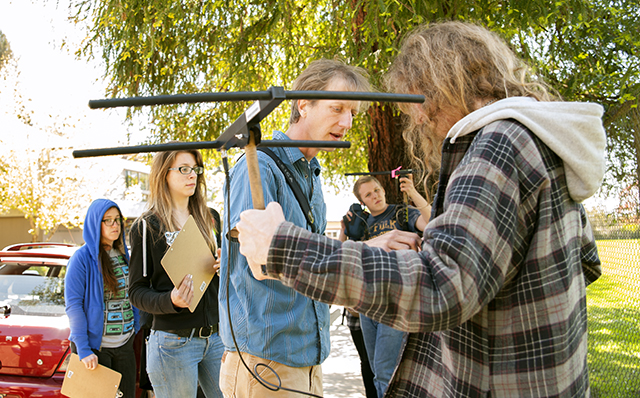Professor Dan Barton demonstrates the use of telemetry in the laboratory portion of his Wildlife Techniques class with a unique exercise that allows students to track the very creatures they’re learning from–Barton and graduate assistant Ryan Baumbusch. Fitted with transmitters, the instructors disperse throughout their range–the HSU campus–while students trace their movements using receivers.

“It can be fun, but in real-world fieldwork it can also be frustrating,” said Barton, who is teaching the class for the first time. “It’s also labor-intensive and expensive.”
Offsetting the drawbacks is the ability to gather information about an animal’s range, habitat selection, migration habits and other aspects of its behavior. More complex equipment can provide data on the subject’s heart rate and other physiological responses.
During a recent session, Barton divided his class into four groups of three to four students, each unit armed with an antenna and receiver. Working together, they established a perimeter that outlined their subject’s (Barton) preferred range, leading them to dub the species “Founders Hall Highland Gorilla.”
Sighting their blue-shirted subject behind Founders Hall, the students made sure not to approach abruptly, following Barton’s pre-exercise directions. “Don’t approach the animal too closely,” he said. “It could be dangerous, so don’t corner it. Observe it in its natural surroundings.”

The most basic telemetry devices consist of receivers, transmitters and antennas. An animal is captured, then fitted with a transmitter affixed to its body via collar, band, backpack or even eyelash cement. All processes carefully minimize the impact and risk to an animal’s normal behavior.
Many species of birds, for instance, must be fitted with precision to assure that flight or the ability to escape predators isn’t compromised, Barton said. On the other hand, a research program conducted by professors Bill Henry and Scott Shaffer at the University of California Santa Cruz that Barton was involved in before his graduate work found that albatrosses are particularly adaptable to their new wardrobe, which is taped to their plumage.
“For whatever reason, they don’t even try to preen themselves there,” Barton said. “They leave it alone. Researchers have tracked albatrosses on hundreds of foraging trips and have never lost a transmitter.”
According to Barton’s students, field experience as an undergraduate has been invaluable to their education. Some, like Austin Collister (’15, Wildlife Conservation and Management), recognize how the field study can better prepare them for a future career.
“This exercise allowed me to learn both the struggles and joys of being a true wildlife biologist,” said Collister, who is currently enrolled in Barton’s class. “When you learn about something in the classroom, there's only so much you can apply. But going out and completing these exercises really made the difference and gave me confidence for when I will enter my wildlife career.”
Classmate Nicolette Nelson (’16, Wildlife) shares that sentiment.
“When we actually do the techniques that we're learning about, it makes them so much more real and memorable than when we learn about them in lecture,” Nelson said. “It's also a great way to get experience that could be helpful during future jobs.”

The course has been offered in its current form for more than 10 years, with several faculty members teaching it. Along with telemetry, the laboratory portion incorporates extensive exercises like a recent field trip to McLaughlin Natural Reserve, which encompasses 7,050 acres in Napa, Lake and Yolo counties and is widely utilized for research and teaching.
“We camped for a long weekend (on McLaughlin land), capturing and handling birds using mist-nets, and also studying nocturnal owls in the field,” Barton said. “I taught the science (and art) of locating and monitoring nests of wild birds, used small mammal traps, track plates, and trail cameras to locate and identify mammals in the wild, and we familiarized ourselves with the natural history of several of California's unique landscapes.”
Barton acknowledges the challenges of providing these types of learning opportunities–organizing a group of 35-plus students, covering expenses, securing permits and maintaining relationships with facilitating parties–but feels the value far outweighs the related workload.
“My colleagues and I view these kinds of experiences as fundamental to the education of future wildlife biologists in the tradition of our great naturalists and professional wildlife managers,” Barton said. “My career in biology began with such experiences, and they enriched my life in many ways. I think I have a duty to pay it forward.”